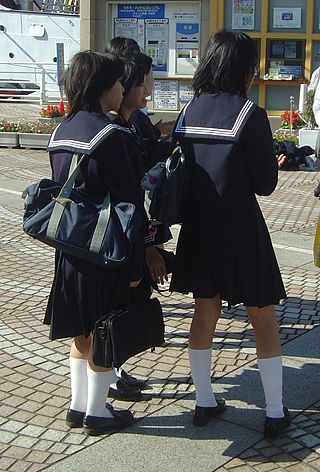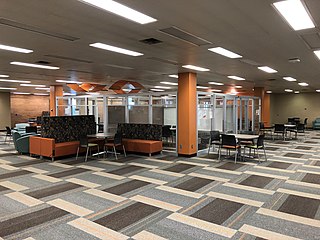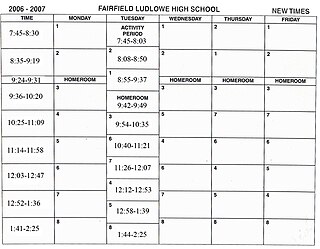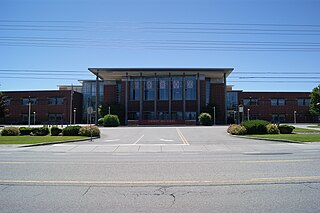Related Research Articles

Homework is a set of tasks assigned to students by their teachers to be completed at home. Common homework assignments may include required reading, a writing or typing project, mathematical exercises to be completed, information to be reviewed before a test, or other skills to be practiced.

Secondary education in Japan is split into junior high schools, which cover the seventh through ninth grade, and senior high schools, which mostly cover grades ten through twelve.

Recess is a general term for a period in which a group of people are temporarily dismissed from their duties.

The European School, Mol was the third of the thirteen European Schools to be established, and is one of five such schools in Belgium. Founded in 1960, it is located in Mol, in the province of Antwerp.
A homeroom, tutor group, form class, or form is a brief administrative period that occurs in a classroom assigned to a student in primary school and in secondary school. Within a homeroom period or classroom, administrative documents are distributed, attendance is marked, announcements are made, and students are given the opportunity to plan for the day. Such periods also act as a form of pastoral care, where teachers and administrators provide personal, social or health advice. Homerooms differ in their nature, depending on the country and the specific school.
A virtual campus or e campus, refers to the online offerings of a college or university where college work is completed either partially or wholly online, often with the assistance of the teacher, professor, or teaching assistant. Many colleges and universities now offer such courses either partially or wholly online. There are an estimated 4,500 such institutions with total enrollments approaching perhaps 2 million.
A virtual university provides higher education programs through electronic media, typically the Internet. Some are bricks-and-mortar institutions that provide online learning as part of their extended university courses while others solely offer online courses. They are regarded as a form of distance education. The goal of virtual universities is to provide access to the part of the population who would not be able to attend a physical campus, for reasons such as distance—in which students live too far from a physical campus to attend regular classes; and the need for flexibility—some students need the flexibility to study at home whenever it is convenient for them to do so.

Elementary school in Japan is compulsory. All children begin first grade in the April after they turn six--kindergarten is growing increasingly popular, but is not mandatory—and starting school is considered a very important event in a child's life.
Aitkin High School (AHS) is a public high school in Aitkin, Minnesota, United States. The school serves students in grades 7–12. The school enrolls approximately 600 students per year, with 400 students in the high school and 200 attending middle school. The school is a combined middle and high school, since the town does not have the needed population of adolescents to include a separate middle school. Class sizes are around 100 students, while some classes, such as the Class of 1978, have enrolled up to 160 students at one time. The Class of 2010 is one of the smallest Aitkin High School classes in history, with a class size at graduation of 83. The class entered with 96 students in 2004. Though the more recent class of 2020 graduated with less than 70.

Study hall, known as private study, SAS, structured study or free periods in the United Kingdom, is a term for a place to have a study time during the school day where students are assigned to study when they are not scheduled for an academic class. They are most commonly found in high schools and some middle schools, especially in the United States. In colleges, such a place may be called a student lounge. It is not to be confused with studying in a hallway.

Bluecoat Aspley Academy is a Church of England secondary school and sixth form located in the Aspley area of Nottingham, England, dating back to 1706. In 2007, the school had 1550 students aged six to eighteen, including 250 Sixth form students. Prior to receiving Academy status in January 2012, the school was titled The Nottingham Bluecoat School and Technology College.

A school timetable is a calendar that coordinates students and teachers within the classrooms and time periods of the school day. Other factors include the class subjects and the type of classrooms available.
St John Plessington Catholic College (SJP) is a Roman Catholic secondary school and sixth form with academy status located in Bebington, Wirral, England. St John Plessington is in partnership with multiple other schools including St Mary's College, Wallasey in the Holy Family Multi Academy Trust.

University High School, often referred to as "U-Hi" or "U-High", is a public high school for grades nine through twelve in Spokane Valley, Washington, United States. It is part of the Central Valley School District in Spokane Valley.
In an educational milieu MSIP can be defined as the either the Manitoba School Improvement Plan or the Multi-Subject Instructional Period. For the purpose of this article the acronym MSIP will be used exclusively to refer to the multi-subject instructional period.

The No. 1 Senior High School of Ürümqi, literally Ürümqi No. 1 High School, colloquially abbreviated as "乌鲁木齐一中" or "乌市一中", sometimes called No. 1 Middle School of Urumqi, is a public high school in Ürümqi, Xinjiang Uyghur Autonomous Region, China, under the jurisdiction of the Urumqi Municipal Education Bureau. Founded in 1891 during the Qing dynasty, it is the oldest school in Xinjiang.

A flipped classroom is an instructional strategy and a type of blended learning, which aims to increase student engagement and learning by having pupils complete readings at home and work on live problem-solving during class time. This pedagogical style moves activities, including those that may have traditionally been considered homework, into the classroom. With a flipped classroom, students watch online lectures, collaborate in online discussions, or carry out research at home, while actively engaging concepts in the classroom, with a mentor's guidance.

École internationale de Montréal (Secondaire) is a public French-language high school located in Westmount, Quebec. It is a part of the Centre de services scolaire de Montréal (CSSDM).

High school or senior high school is the education students receive in the final stage of secondary education in the United States. In the United States most high schoolers are ages 14-18 but some ages could be delayed due to birthdays. Most comparable to secondary schools, high schools generally deliver phase three of the ISCED model of education. High schools have subject-based classes. The name high school is applied in other countries, but no universal generalization can be made as to the age range, financial status, or ability level of the pupils accepted. In North America, most high schools include grades 9 through 12. Students attend them following graduation from middle school.
Modular scheduling is a system of timetabling in certain high schools in the United States.
References
- ↑ "Definition of Class Period by The Free Dictionary". Farlex. Retrieved July 22, 2011.
- ↑ "The Times of India: Gill wants a compulsory sports period in schools". The Times Of India. April 25, 2010. Retrieved July 22, 2011.